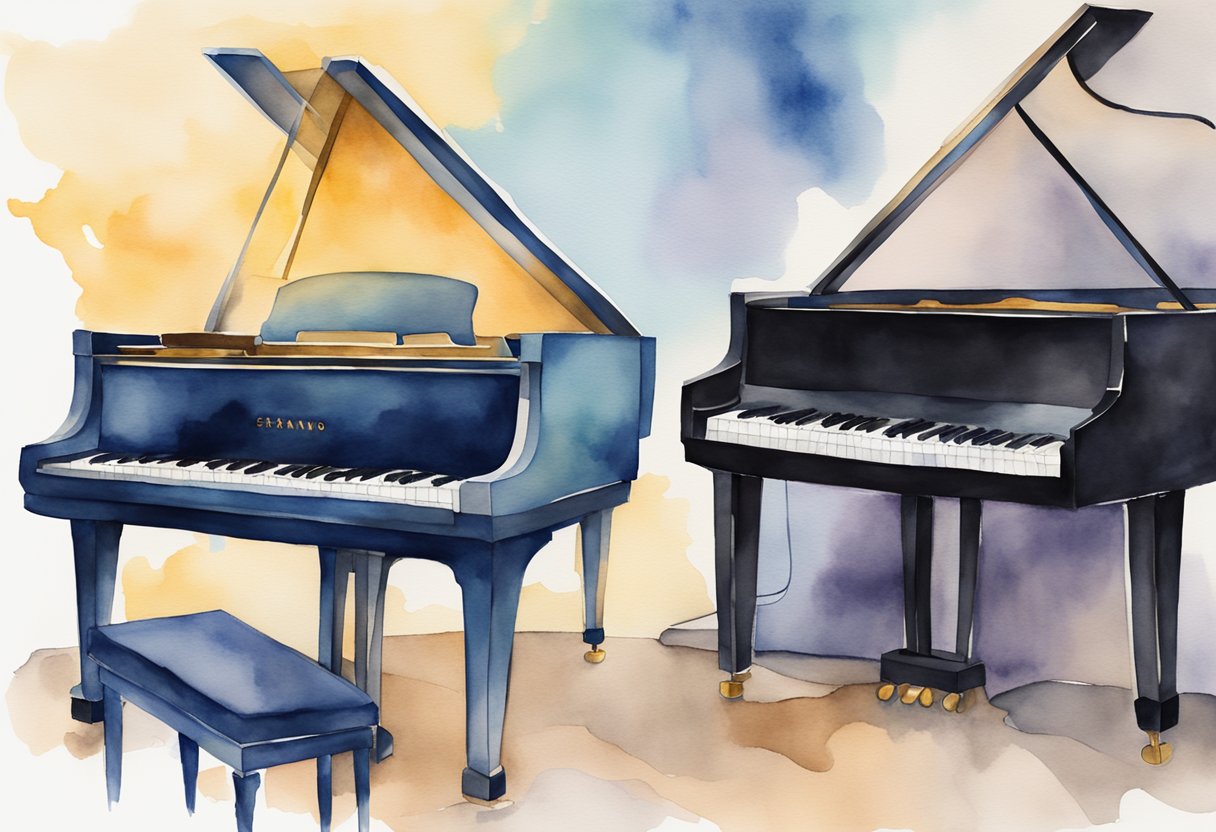As an Amazon Associate I earn from qualifying purchases.
When you consider the classic image of a piano, you might picture an acoustic piano, complete with its large wooden frame and strings. These instruments don’t need to be plugged in, as their sound is produced mechanically through the striking of strings by hammers, which resonate throughout the wooden body and are projected acoustically.
Whether you’re seated at a majestic grand piano or a more compact upright piano, the principle remains the same: press a key, and a hammer hits a string, creating the pure, organic sound we associate with these beautiful instruments.
Want to Learn Piano?Click Here

However, when you venture into the world of digital pianos and electric pianos, you’ll find a different story. These instruments require a power source because they rely on electronic sound production.
When you press a key on a digital piano, instead of a hammer striking a string, you activate a sensor that triggers a digitally sampled sound through a speaker system. This can be particularly convenient for modern musicians who need a variety of sounds, recording capabilities, and the ability to practice with headphones for privacy.
Now, if you’re considering owning or playing pianos that fall outside the traditional acoustic category, like digital, electric, or hybrid pianos, knowing the necessity of power supply is crucial.
These instruments might need to be plugged into an outlet, or they might operate with the flexibility of batteries, making them more portable.
Understanding Piano Types and Power Requirements

When choosing the right piano for your needs, it’s crucial to consider not only the type—acoustic or digital—but also the power requirements, as these factors significantly influence the instrument’s functionality and portability.
Acoustic vs. Digital Pianos
Acoustic pianos, including grand and upright models, are traditional instruments that produce sound mechanically. When you press a key, a hammer strikes a string, creating vibrations that are amplified acoustically through the piano’s body.
Acoustic pianos do not require a power source such as electricity or batteries to operate; however, they may have small electronic components for features such as a built-in metronome or digital player systems, which do need power.
On the other hand, digital pianos emulate the sound and feel of acoustic pianos using digital technology. They require electricity to power their sound production and additional features like volume control, different sounds, and sometimes even integrated learning software. Without a power source, digital pianos cannot produce sound.
Power Sources for Various Piano Models
The power sources for different piano models can vary:
- Acoustic pianos with digital components:
- May require batteries or connection to an electrical socket for the electronic features.
- Standard digital pianos:
- Typically need to be plugged into an AC (alternating current) outlet to work.
- Portable keyboards or battery-powered digital pianos:
- Can run on replaceable or rechargeable batteries, adding convenience for traveling musicians.
For example, if you’re practicing at home without the concern of moving your piano, an AC-powered digital model would be suitable. If you’re a performer on the go, a battery-powered option provides the flexibility you need.
Here’s how the power requirements generally break down:
| Piano Type | Power Source Required | Notes |
|---|---|---|
| Acoustic Piano | None | May need power for additional digital features. |
| Digital Piano | AC (outlet) or battery | Essential for operation. |
| Portable Keyboard | Battery or AC (outlet) | Offers more flexibility. |
Maintenance and Functionality
When you take care of your piano, it functions at its best, and staying plugged in plays a crucial role. Let’s explore how regular maintenance and electricity contribute to your piano’s performance and sound quality.
Benefits of Regular Maintenance
Regular maintenance is vital in ensuring that your digital piano operates smoothly and lasts longer. By keeping your piano in top shape, you avoid common issues that can hinder your performance and potentially lead to costly repairs.
For instance, dust and debris can accumulate in the keys, causing them to stick or fail to produce the correct sound. Regularly cleaning your piano and checking for any signs of wear will help maintain its functionality and performance.
Impact of Electricity on Piano Function
Your digital piano’s function relies heavily on a steady power supply. Being plugged in is not just about turning it on; it’s about providing the consistent electricity needed for the complex digital processes that create the rich and nuanced sounds you love.
Fluctuations in power can lead to sound distortions or even damage the sensitive electronic components inside, which is why a stable electrical connection is imperative.
Ensuring High Sound Quality
The sound quality of your piano is a direct reflection of its condition and how well it’s been maintained. Just like an acoustic piano requires tuning to sound its best, a digital piano needs regular checks to ensure that the speakers and software are functioning correctly.
Without this maintenance, your piano’s sound can degrade over time, affecting longevity and enjoyment.
Heat can also affect your digital piano’s sound quality and longevity. Avoid placing your piano near heat sources or in direct sunlight, as excessive heat can cause damage to the internal components and negatively impact its performance.
Hello & thanks for stopping by! I’m a professional concert pianist and piano instructor. In the United States, I’ve given successful performances in several places including New York, Florida, Connecticut, & New Jersey, I have also performed internationally in Italy and made my Carnegie Hall debut in 2014. I enjoy blogging about the piano, the art of performance, general music, current events and the latest in music production.
